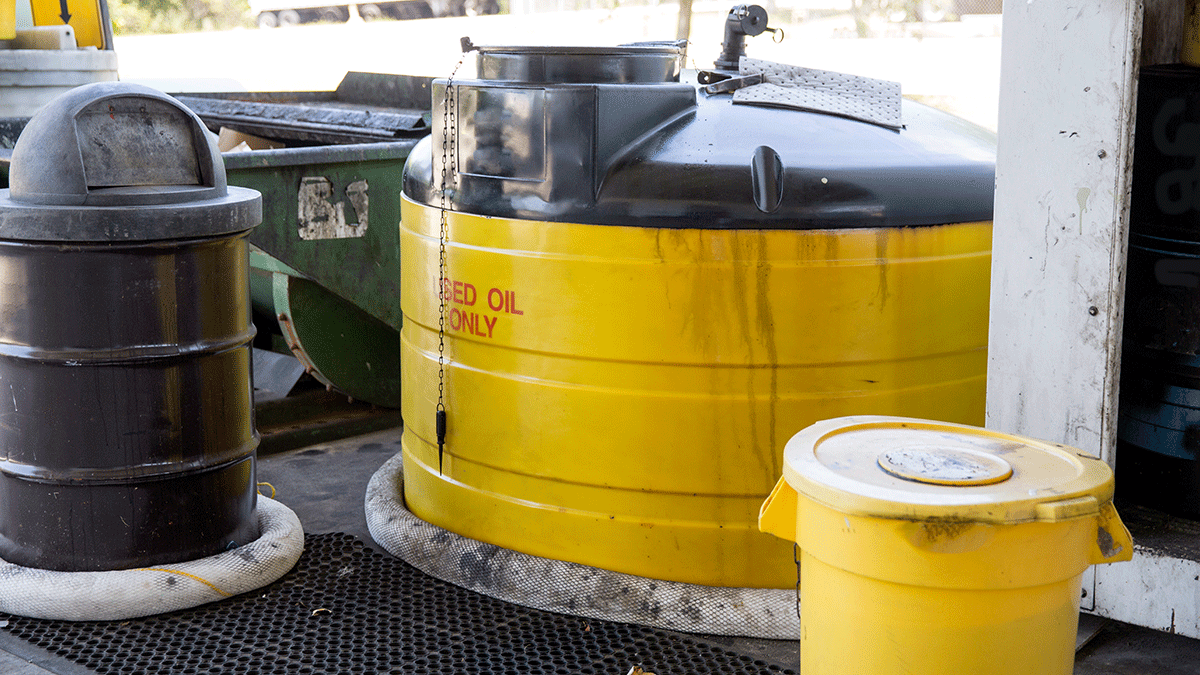While most motorists pay someone to change their oil, about 25% of us still crawl under our vehicles and do it ourselves. When we’re done, what do we do with the used motor oil? Here are some tips for proper used oil disposal.
It should go without saying, but dispose of it properly.
I remember my father draining blackened motor oil from our Oldsmobile Delta 88 back in the early ’80s and burying it in the backyard.
According to the Environmental Protection Agency, the used oil from a single oil change can contaminate 1 million gallons of fresh water – a year’s supply for 50 people. Just one quart of used oil can produce a two-acre slick.
Don’t be like my father.
Here are a few options for proper used oil disposal.
According to the Environmental Protection Agency, the used oil from a single oil change can contaminate 1 million gallons of fresh water.

Take Used Motor Oil to an Auto Parts Store or Quick Lube
Many businesses that sell or change motor oil accept oil for recycling free of charge. For example, most Advance Auto Parts and AutoZone stores accept used motor oil. Likewise, many Jiffy Lube stores are designated oil recycling collection centers. Call the businesses in your area to ensure they’ll take your used oil.
You can also look for places for used oil disposal on www.earth911.com.
Do these businesses a favor and ensure the used motor oil is properly stored in clean plastic containers (not with dirty oil dripping down the sides). It’s convenient to simply use your empty oil bottles as used-oil storage containers.
Avoid mixing used motor oil with antifreeze. Some collection centers won’t take motor oil mixed with antifreeze.
Don’t forget the oil filter. Most collection centers also recycle used oil filters. In fact, since used oil from discarded oil filters can leak into the soil and water, many state and local governments have banned their disposal in area landfills. Like used motor oil, used oil filters are highly recyclable, and the steel can be used to manufacture a variety of new products, such as construction materials, vehicles and appliances.
Take Used Oil to a Municipal Recycling Facility
In Duluth, Minn., where I live, our local government operates a couple materials recovery centers that accept used motor oil and filters (among other household goods) for recycling. Once a year I head over with my five-gallon container of used oil and all my filters. It only takes a few minutes and it’s free. Plus, I sleep well at night knowing my used oil isn’t buried in the back yard.

How to Recycle Motor Oil Bottles
You can also recycle your motor oil bottles rather than toss them in the trash where they could end up in a landfill. Those empties contain residual oil that can contaminate groundwater.
Many businesses that accept used motor oil will also take empty motor oil bottles. It’s easiest to simply pour the used oil into your empty bottles and dispose of both at the same time.
Municipal recycling facilities typically also recycle motor oil bottles. However, disposal varies from city to city, so call ahead to be sure.
If all the vehicles in North America used AMSOIL synthetic motor oil for extended drain intervals, we could eliminate billions of gallons of used oil.
What Happens to Used Motor Oil That’s Recycled?
Used motor oil can be used to power industrial plant boilers or other industrial heating applications.
In fact, recycling just two gallons of waste oil can generate enough electricity to run the average household for nearly 24 hours.
It can also be distilled into diesel or marine fuel.
Used motor oil can also be re-refined and used to make new motor oil. Refiners can restore the lubricating qualities of base oils, remove contaminants and introduce new additives to create a new product.
Here’s Another Option – Create Less Waste Oil
The best way to deal with used motor oil is to create as little as possible.
The motor oil market today contains multiple oils recommended for extended drain intervals. Some even allow you to go a full year between oil changes if you choose.
At the risk of sounding immodest, AMSOIL was the first oil company to promote extended drain intervals. Back in 1972 we were making synthetic oil recommended for up to 25,000 miles or one year, whichever came first.
Today, we offer AMSOIL Signature Series Synthetic Motor Oil, which provides extended drain intervals up to 25,000 miles (normal service), one year or 700 hours of operation, whichever comes first.
We also offer XL Synthetic Motor Oil, which is recommended for up to 12,000 miles/one year, or longer when recommended in owner’s manuals or indicated by electronic oil life monitoring systems.
Extending drain intervals dramatically reduces the amount of waste oil generated.
If all the vehicles in North America used AMSOIL synthetic motor oil for extended drain intervals, we could eliminate billions of gallons of used oil.
Not only that, but changing oil less often also reduces packaging waste, not to mention the time you spend changing oil.
Regardless how often you elect to change oil, just make sure your used oil disposal plan doesn’t include burying it in your backyard.









Comments
AMSOIL Technical Writer and avid avid DIYer with 12 years in the synthetic lubricants industry, who enjoys making technical topics in the automotive, powersports and industrial markets easy to understand.
Share: